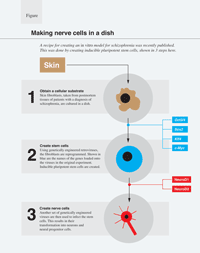Publication
Article
Psychiatric Times
Modeling Schizophrenia: An In Vitro Model of a Tough Disease
Author(s):
This column has always been about the world of molecular mental health research. I revisit the technology in this column, now aimed at one of molecular neuropsychiatry’s most intractable, frustrating lines of research: the molecular/cellular basis of schizophrenia.

This column has always been about the world of molecular mental health research. In the April issue of Psychiatric Times, I discussed how adult stem cells were being used to aid in research on a neurological disorder (spinal muscular atrophy). I revisit the technology in this column, now aimed at one of molecular neuropsychiatry’s most intractable, frustrating lines of research: the molecular/cellular basis of schizophrenia.
I use the word “frustrating” because a biological explanation for the disease seems heartbreakingly just out of reach. Schizophrenia has a powerful genetic component (heritability percentage is in the low 80s), something I’ve known for years, something that could make it low-hanging research fruit. There is also a large clinical base on which to do studies: schizophrenia afflicts millions of people (the estimated prevalence rate is about 1% of the global population). Despite these seeming advantages, a molecular mechanism capable of describing all aspects of schizophrenia has almost completely eluded researchers.
There’s a simple reason for this. A deep understanding of schizophrenia at such an intimate level has been hampered by a single technical bottleneck: the lack of a robust in vitro disease model.
That may all be about to change. The results from a study that used cells derived from a deceased patient’s skin tissue has recently been published.1 Findings from the study may provide just such a model. It is not yet full-fledged schizophrenia-in-a-dish, but the findings portend a powerful future for the field. I’d like to tell you what happened. I’ll start with a brief review of hiPSCs (human inducible pluripotent stem cells), then move to the data.
Pluripotent stem cells
August 2006 is a landmark in the field of regenerative medicine. An article published that month from a group in Kyoto, Japan, described how to take garden-variety mouse skin cells and turn them into pluripotent stem cells.2 It was reported that stem cells have an ability to transform themselves into different cell types, depending on the tissue, essentially at the scientist’s whim.
Researchers had been trying to harness this power for a long time, and for good reason. Such technologies could be useful for screening the effects of drugs, valuable as replacement therapies for damaged tissues, and relevant to this article on creating disease models. The cells are formally termed “iPSCs.” I received a further shock when a year later, the same research group did the same trick with human cells.3
Four separate gene sequences are loaded onto genetically reengineered retroviruses (members of the genus lentivirus, which includes HIV). These viruses are allowed to infect a host skin cell, and because they are retroviruses, they immediately integrate into the host cell’s DNA. For reasons not fully understood, this integrated gene combination goes right to work reprogramming the skin, transforming it into a batch of versatile iPSCs. One of the most interesting of the 4 retroviral-stitched sequences is called Myc, which before this work was mostly known for causing cancer.
Once there was a reliable way to manufacture healthy hiPSCs, scientists could turn their attention toward their most important goal: learning how to create the cell type they wanted to study. It did not take long for researchers to discover how to turn hiPSCs into functional neurons. It took a slightly different combination of genes stitched onto their retroviral transports (Figure). iPSCs were infected with this combination and, voil, functional neurons began to grow in a dish.

With these technologies in mind, I now have the tools needed to understand how to create a dish-bound model of schizophrenia. It involves answering some simple questions: What if you took the skin cells from patients who had schizophrenia and turned them into neurons? Would they exhibit behaviors of typical, healthy cells? Or would they exhibit behaviors reminiscent of previously determined properties of neurons in patients with schizophrenia? If the latter were observed, would you have a robust cellular model of schizophrenia, the missing link in this line of work? A consortium of researchers from Pennsylvania, San Diego, and New York decided to pool their resources and find out.4
Experimental protocol
Primary fibroblasts derived from postmortem samples of patients with a formal diagnosis of schizophrenia were obtained and cultured. These were infected with retroviruses using iPSC protocols such as the ones described above. Would skin cells from diseased patients make iPSCs that were similar to fibroblasts obtained from unaffected people? They did indeed. Once obtained, these iPSCs were even reprogrammable, and soon either neurons or NPCs (neural progenitor cells) from deceased schizophrenic individuals were growing in the dish.
The most interesting result came from what happened next. Even though the reprogrammed cells were clearly neural tissue, they did not behave like typically functioning neurons. Several observed differences were eerily similar to previous findings other researchers had seen in tissue samples from patients with schizophrenia.
Dendritic arborization. Neurons derived from patients with previously diagnosed schizophrenia exhibit specific, aberrant properties. Postmortem examination of neural tissue reveals a significant reduction in dendritic arborization in many patients, which may result in aberrant neural connectivity and subsequent behavioral abnormalities.
This same reduction was observed in the reprogrammed cells. The cells showed a decrease in neurite numbers (a neurite refers to any projection from a neuron’s cell body). This resulted in a loss in neural connectivity in these same populations. It is interesting to note that the application of the antipsychotic loxapine to these cells significantly restored their neuronal connectivity. (Four other antipsychotics did not.)
It should be noted that these cells were all fully capable of spontaneous neural activity. In response to normal membrane depolarization events, for example, these cells displayed typical inward sodium currents (transient) and more sustained outward potassium currents.
Changes in neuregulin expression. A number of genes whose aberrant expression profiles are associated with the disease state in other individuals showed up in these reprogrammed cells. One of the most dramatic was an increase in NRG1 (neuregulin) expression. NRG1 is part of a group of glycoproteins in the epidermal growth factor family. This elevation was not seen in the cultured fibroblasts or in the iPSCs (nor was it seen in the NPCs). Why is NRG1 important? Previous work has shown that mutations in this gene were highly associated with the prevalence of schizophrenia in Icelandic populations. The specific involvement of neuregulin in these cells thus represents an important finding.
Global gene expression changes. There are techniques that allow researchers to assess the “gross domestic product” of gene expression profiles in given cell populations (essentially a global assessment of class 2 gene expression). Such analysis was performed, and findings were compared with those from nondiseased controls and with genes previously implicated in schizophrenia. It was found that 25% of the genes differentially expressed in the reprogrammed cells had been previously implicated in schizophrenia. These were not trivial genes. Further analysis (gene ontology examinations) demonstrated changes in glutamate signaling, as well as WNT and cyclic adenosine monophosphate signaling pathways.
The bottom line is that many of the major cellular and molecular aberrations previously demonstrated in diseased tissues were showing up in these reprogrammed cells. A robust living cell model, derived exclusively from postmortem samples from patients in whom schizophrenia had been diagnosed, seems to have been achieved.
What this means
Although this is truly a significant result, there are specific caveats. Some have to do with the fact that relatively “simple” tissues growing in a dish do not mimic the complex, real world of the living brain. Other objections have to do with the technology.
iPSCs are notorious for carrying mutations that may have very little to do with the real in vivo world. Retroviruses insert at random DNA sites in the genome, which introduces the risk of gene disruption. Moreover, genes such as the aforementioned Myc, greatly increase the efficiency of reprogramming cells, which means they are nice to have around if you are doing this type of research. However, Myc is also an oncogene, which means it is a sequence capable of inducing cancer. Does that introduce any uncontrolled variables? At this point, no one knows.
None of these objections seriously undermine the great potential of this result, of course. Having a dish filled with cells that carry many characteristics of a human disease is a lot like having a flashlight in a dark cave. The greatest utility is in the ability to illuminate molecular mechanisms that might go undetected without such a model. It can go a long way toward relieving the frustration often associated with this line of work. Give it enough time and it might even-someday-illuminate a cure.
References:
References
1.
Brennand KJ, Simone A, Jou J, et al. Modelling schizophrenia using human induced pluripotent skin cells.
Nature
. 2011;473:221-225.
2.
Takahashi K, Yamanaka S. Induction of pluripotent stem cells from mouse embryonic and adult fibroblast cultures by defined factors.
Cell
. 2006;126:663-676.
3.
Takahashi K, Tanabe K, Ohnuki M, et al. Induction of pluripotent stem cells from adult human fibroblasts by defined factors.
Cell
. 2007;131:861-872.
4.
Sendtner M. Regenerative medicine: bespoke cells for the human brain.
Nature
. 2011;476:158-159.






